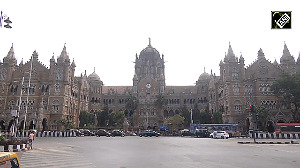The rules of the game are changing. With most airlines realising that they will barely be able to keep themselves afloat as far as margins in the economy class are concerned, they are putting their focus on the executive and first classes.
And with a large number of Indians changing their preference in favour of travelling comfortably, premium classes are witnessing rising seat loads, especially in flights headed to London, New York, Tokyo and Singapore. These trends are also pushing up airlines' bottomlines.
Take Emirates, which has seen a 15-20 per cent rise in its revenue ever since the company started premium classes on the Indian sector five years ago.
Besides, the seat utilisation is on the rise. "Our business class has an average occupancy of 70 per cent and first class 60 per cent, which are quite good considering the fare difference between economy and these classes. More and more Indians these days prefer to travel luxuriously," says Nabil Sultan, senior vice president-commercial operations, West Asia and Indian Ocean, Emirates.
Similarly Lufthansa, which has a seat load factor of 85 and 87 per cent on its Delhi-Frankfurt and Mumbai-Frankfurt routes respectively, claims its first and business classes are very popular.
The airline, which started a direct flight from Hyderabad in February this year, has eight seats in first class and 42 in business class. Lufthansa claims it ensures impeccable services to first class passengers, giving them little choice to fly any other airline.
With the open sky policy, business and first class have also become major revenue providers for a number of airlines. Agrees Sultan of Emirates: "The economy class has had to face the brunt of price undercutting, but premium classes earn good and stable revenues for airlines."
Despite the high initial cost of reclining and flat seats, and the recurring expense on food and beverages, and the high crew to passenger ratio resulting in higher maintenance of premium classes, the difference in margins more than compensate for cost incurred on these.
For instance, while Air-India's economy return fare to London, ex-Mumbai, is Rs 27,000, that of first class is almost five times (Rs 140,000) and business class over three times (Rs 105,000).
Again, on the New York route, while the economy class return ticket is Rs 45,000 that on executive and first class is a steeper Rs 144,000 and Rs 234,000 respectively.
That explains why Air-India beefed up its first and executive class. "Air-India's fares were lower two years ago as its first class lacked the amenities that other airlines were offering. But we have caught up with them after the introduction of flat-bed seats in first class and slumberettes in executive class," says Air-India's Jitender Bhargava.
And to get more people to travel premium class, Air-India has introduced the concept of free companion travel and accumulation of travel points.
Airlines are also making concrete changes in their premium classes. For 180 degree flat beds, suites, five- to seven-course meals, expensive wines and fine cutlery are now the norm with most.
Lufthansa, for instance, is providing broadband Internet access on its long-haul flights. "With Flynet, passengers can surf the web at speeds they are accustomed to on the ground," claims a Lufthansa spokesperson.
Similarly, Emirates has invested $8 million (Rs 36 crore) on its ICE (information communication and entertainment products) that offers passengers a choice of over 100 movies and 50 TV channels. Besides, it is spending $1.8 billion (Rs 8,100 crore) in re-inventing long haul travel.
Not just that. Each new first class suite is costing Emirates $1,25,000 (Rs 56.3 lakh). The company is also introducing mood lighting to take care of passengers' internal body clocks and minimise jet lag.
And with India being the biggest revenue earner in West Asia and Indian Ocean region, Emirates has been giving special focus to the country.
For better legroom in the flight to Mumbai, the first class seats were reduced from 18 to 12, and in business class from 42 to 27. Singapore Airlines has also done this.
It reduced the number of SkySuites from 16 to 12 and the company claims that the spaciousness strikes a passenger immediately on entering the cabin -- a selling point for the airline.
Still others like British Airways, which was one of the first airlines to introduce first class, re-designed this class by hiring leading British interior designer Kelly Hoppen and investing £20 million (Rs 90 crore) on the project.
According to the company, this was part of British Airways' biggest-ever programme of product improvements for premium passengers.
To outdo each other, airlines are personalising services for their first class passengers. British Airways provides them access to the Molton Brown Travel Spa at Heathrow and New York's JFK airport, which offer complimentary therapies.
The spas offer a range of therapies including those associated with colour, sound, mood and sensation. Similarly, with Singapore Airlines, a passenger can order his favourite dish in advance through its Book the Cook service.
If the pampering comes at a price, it's because airlines have realised it's easier to charge for premium travel, rather than in cattle class where competition has driven down fares.







 © 2025
© 2025